23-30 January 2014. We flew from Cusco to Lima for a week in the city. I wouldn’t put Lima at the top of the list of places to go to in Peru, but it was a very useful time for a number of reasons, and we found some interesting things to see and do. Still, I think Lima got short shrift from us. We were worn out from all the time at altitude in the Andes, and we only had one week there compared to three weeks in Buenos Aires. With three weeks we had plenty of time to explore the city at a leisurely pace, whereas in Lima we were feeling lazy and didn’t even get to the beaches.
Lima is a big sprawling city, and like most cities it has a variety of neighbourhoods, from the upscale Miraflores to tenacious shantytowns hanging on bleak hillsides. We stayed in an apartment in Miraflores. We did visit one of the most down-home parts of the city to go to the markets for some things I needed for our trip to the Amazon. We were warned about thieves there, and to not be in that part of the city at night.
Lima sits at the top of high cliffs, with the beaches way below. With more time or energy I imagine we’d have figured out a way to get to them short of flying.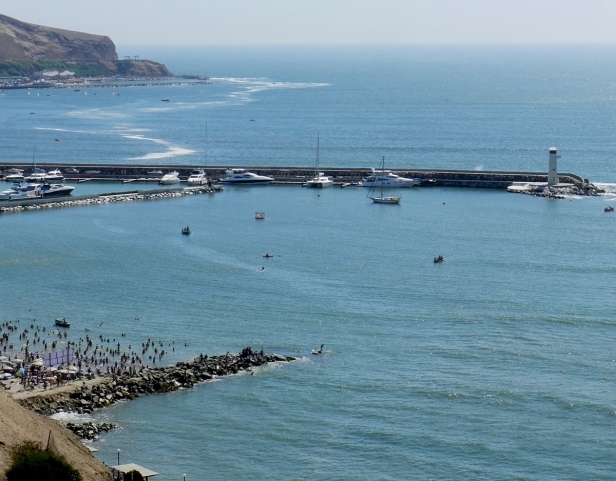
This is the lovely La Rosa Nautica restaurant. With more time or energy, I imagine we’d have also gone exploring down there on that breakwater.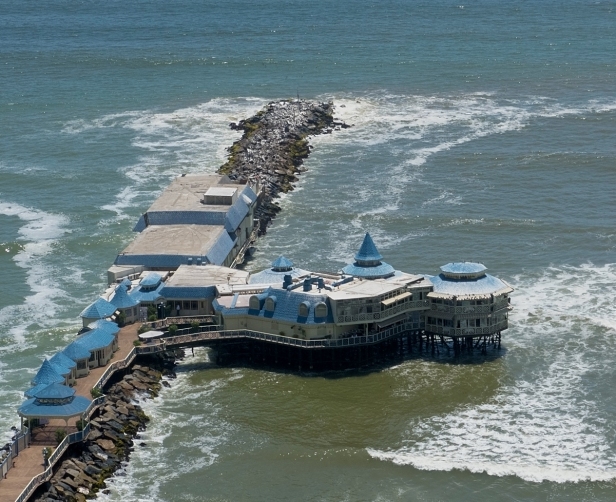
In between resting quite a bit, shopping for things for the Amazon, and taking part in a live online interview with Nomadic Matt, that first involved hunting down a telephone cable for a direct internet connection, we dutifully found the energy to go see at least some of the attractions of the city.
First a walk to Parque Kennedy to the tourist office to get a map of the city, and what should we stumble into but dancing in the street! There were two different groups and they were advertising the Candelaria Festival to be held the following week in Puno. It was one of the more exciting things we saw in Lima. Certainly it was for me, who loves any kind of local festivity, the more colourful the better.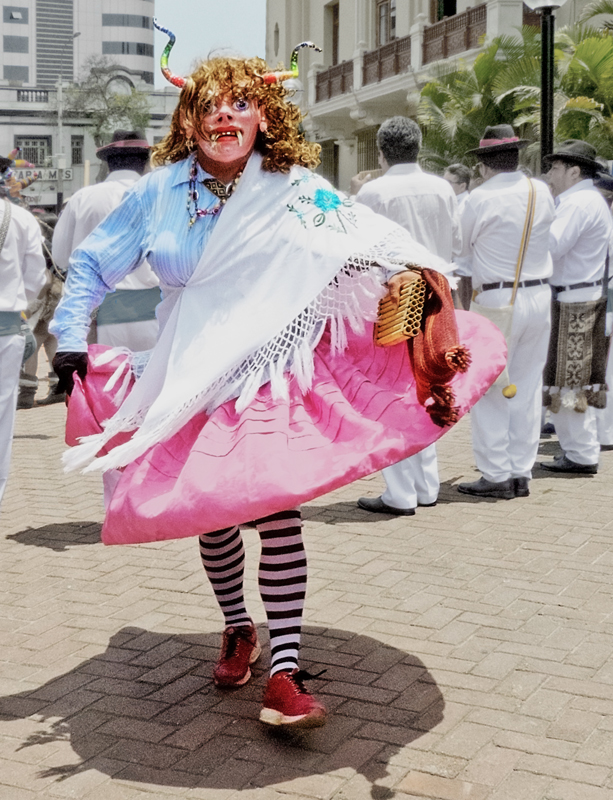
There will be many more photos to come when I get to posting about Candelaria. There will probably be so many photos of colourful and fantastical costumes that you will all be heartily sick of them.
Our next outing was to the downtown core, the beautiful old colonial centre of the city, to see the Changing of the Guard, every day precisely at noon, at the Government Palace, residence of the President. It was a fine display of military pageantry – all shiny shoes and buttons, tasseled top hats and massive manly epaulets, big guns and precision marching.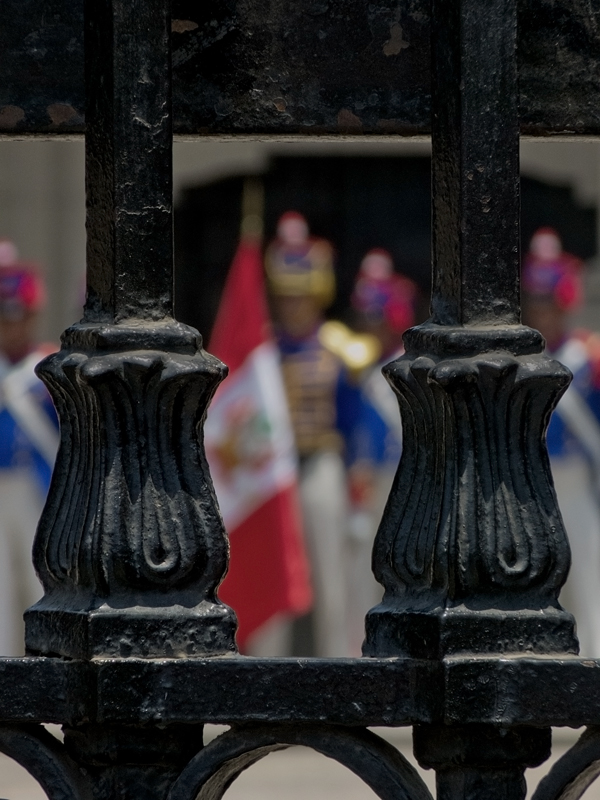
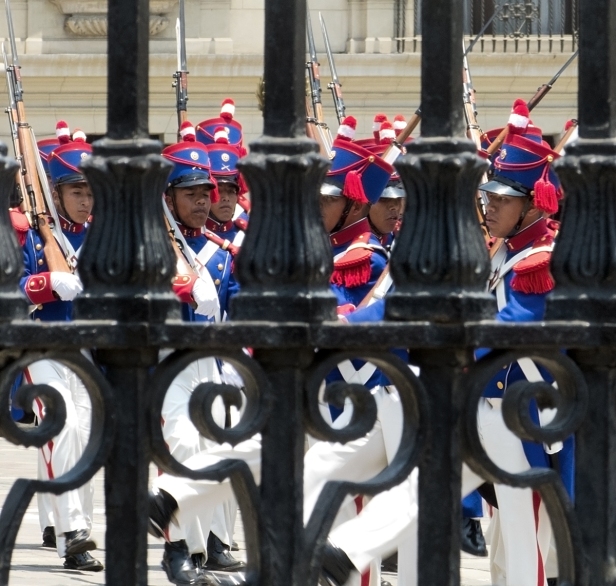
It was entertaining. So was this guy, all stern and official while the ceremony was happening, then afterwards playing with some kids and posing for photographs with tourists.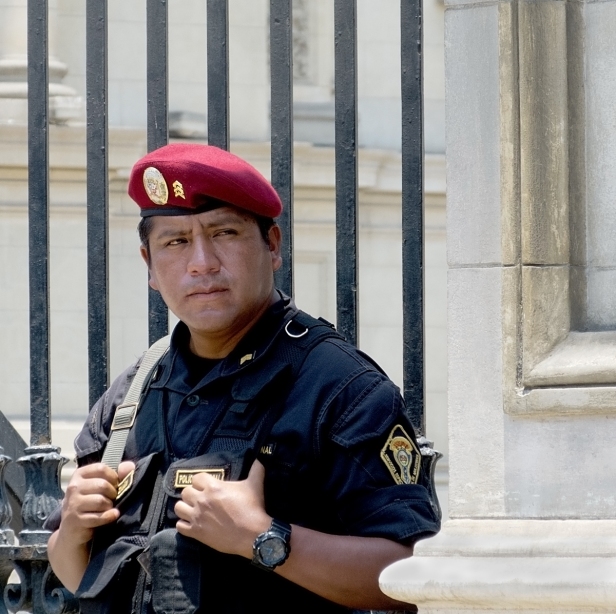
The Government Palace forms one side of the beautiful Plaza des Armas, the main square in the city centre.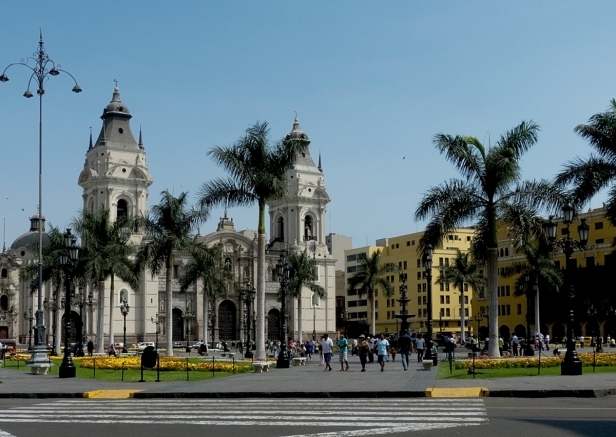
And just down the street – the exquisite Palacio Torre Tagle, built in 1730 by the eponymous Marquis.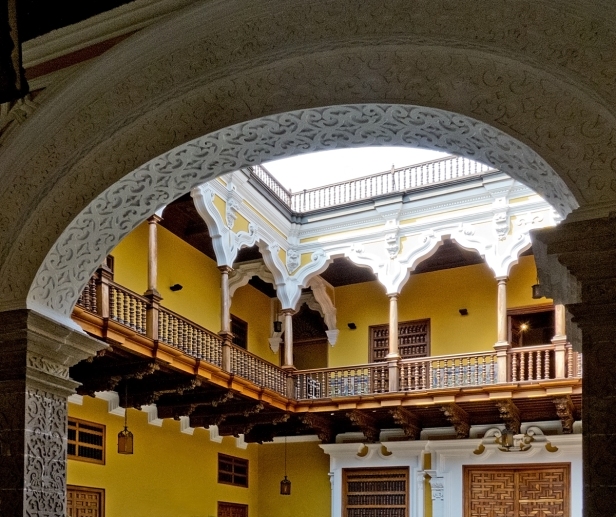
In the same neighbourhood are the Church of San Francisco and the adjoining monastery. Everyone, including us, goes for the bones. The catacombs used to be part of Lima’s original cemeteries, which were built under churches, and apparently there are the bones of about 75,000 people in there – many arranged in patterns in deep circular pits. I saw this when I was in South America thirty-odd years ago and always remembered it. Well really, how could you forget climbing down way below a church, walking on dusty floors through tiny, cramped, low-ceilinged pathways and being confronted with thousands upon thousands of human bones? There are trays of bones, shelves of bones, and the aforementioned deep circular pits of bones, one of which, if I remember correctly, contains the bodies of 10,000 people. They are all neatly placed in a pattern according to the type of bone – a circle of femurs, and then a circle of skulls, then a circle of ulnas, or some such, then more skulls, the pattern maintained from the bottom up. I wonder what it was like for those whose task it was to neatly stack all those thousands of bones. I used to think they were the bodies of those killed in the Spanish Inquisition, but I now know they are the bodies of the nobility. I don’t know why the bones aren’t still buried. Presumably they once were. Maybe they just ran out of room and had to dig them up and stack them. It’s deep and dank and pinched down in those catacombs, be careful how you walk. Dem bones, dem bones, dem dry bones . . . . . . .
Apart from bones the one thing I remember from our tour of the monastery is some exquisite illuminated manuscripts brought from Spain soon after the conquest of the Incas.
The Church of San Francisco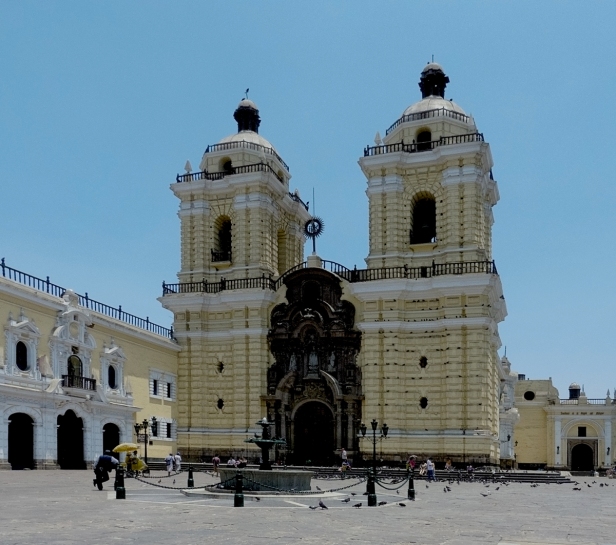
Downtown reflection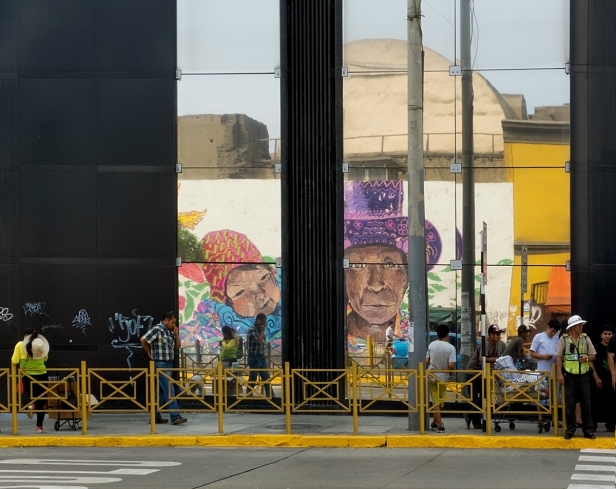
Huaca Pucllana is pronounced waka pook yana. When I told Don I’d been writing about it his response was waka fook yana is that?
Huaca Pucllana is a massive, ancient, seven-stepped, sacred pyramid built from hundreds of thousands of hand-made mud bricks for ritual, ceremonial and sacrificial purposes. There’s a large plaza next to it, and an area that seems to have been for fish and marine offerings to the gods, and an administrative centre. It was built by the Lima Culture, the name given to the indigenous people of the Lima area. This civilization developed on the coast from 200 to 700 AD, several hundred years before the rise of the Inca. There were originally fourteen pyramids, and about fifty buildings, and a huge irrigation system from the Rimac River. The pyramid was a display of the power of the priesthood who controlled the use of both fresh and sea water, and in that way controlled the people: it was ever thus.
Their mud-brick manufacturing skills are truly legendary. It baffles the mind how many people it took, and how many bricks had to be made, to build even one of these pyramids. I imagine the brick makers were slaves, but it’s impressive the drive for power and control over others, and the need to appease the gods, that leads to the command for the construction in the first place. Not just one, but over the years, fourteen! All built of mud bricks, all built by hand. Millions of bricks. Staggering.
The Lima people were later taken over by the Wari people, and a large city developed here. Eventually it came under the control of the Inca who expanded the city even more. Most of it has been destroyed to build highways and stadiums.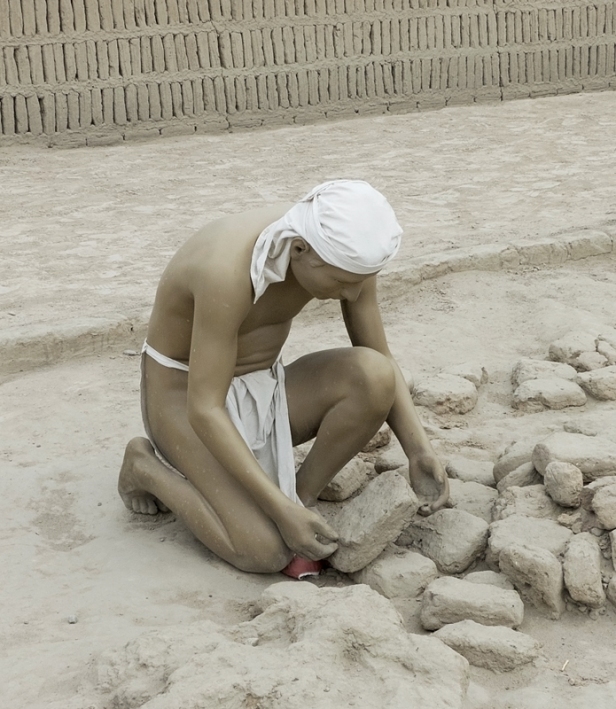
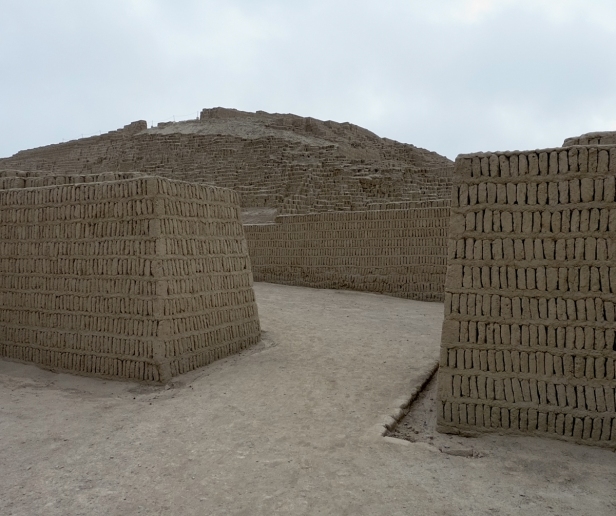
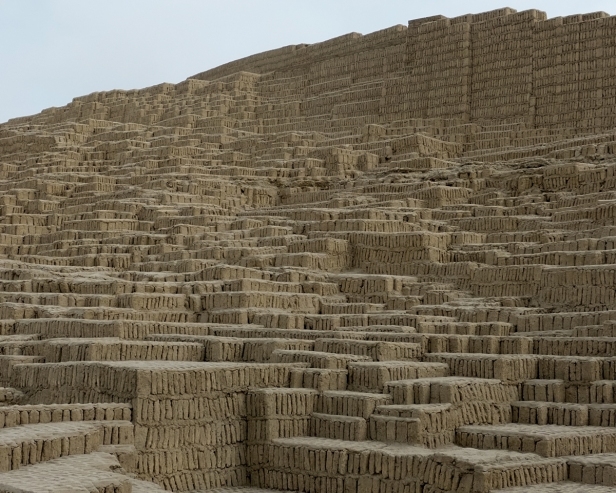

We rented unfortunate bikes one day. Well I think Don’s bike might have been sort of okay, but mine was quite unfortunate. Like Don’s, it had no gears. It was slightly out of alignment so I was fighting the steering all the time. It had only one hand brake, and a back brake on the pedal that barely worked. I haven’t used a brake on the pedal since I was a child, and have since ridden literally thousands of kilometres with both front and back brakes controlled by handlebar levers. Muscle memory well ingrained. In the event of an emergency – an unexpected truck rushing around a corner – it didn’t occur to me to push back on the pedal. I grabbed hold hard of the only hand brake I had and promptly tipped the bike and me onto the ground. Oh Joy. Apart from that it was a fine day out riding along the paths through the nine kilometres of parks on the top of the cliffs of Lima high above the Pacific Ocean, and then out to the suburb of Barranco. There are some pretty grand sculptures in those parks. And some glorious views.
The Lovers by Víctor Delfín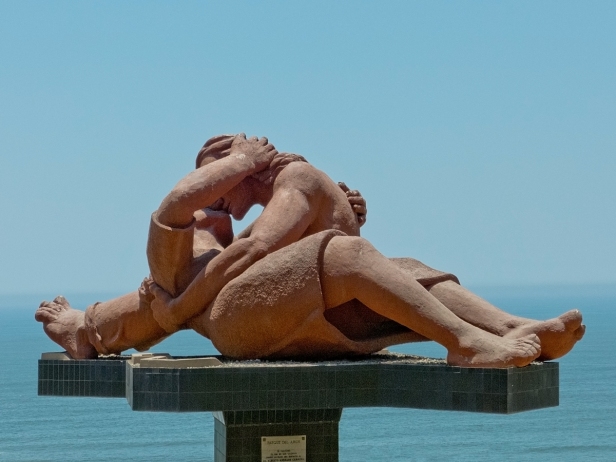
And below them some very Gaudiesque seating in the Parque del Amor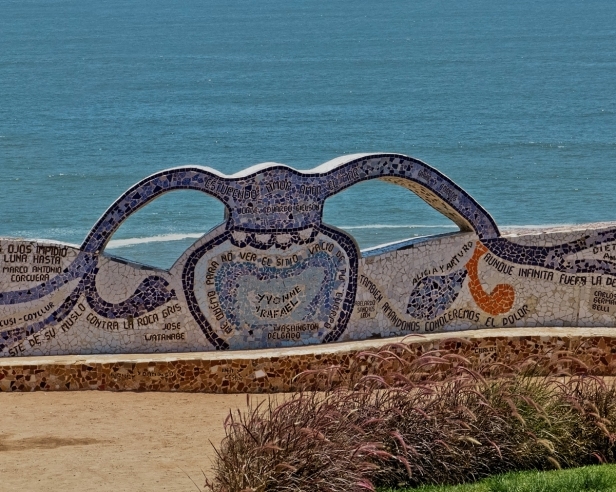
Silencio by José Tola. Apparently many of the locals don’t like this one. I don’t either.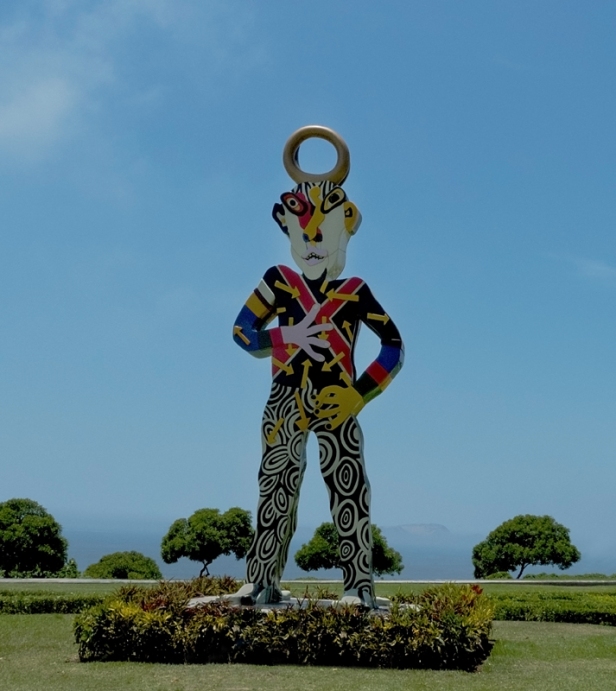
Out in Barranco we found the Iglesia la Ermita that was completely destroyed by invading Chilean troops in 1881, rebuilt, and then later damaged by an earthquake. In the meanwhile a large wake of vultures calls the battered belfry home. The first photo is Don’s.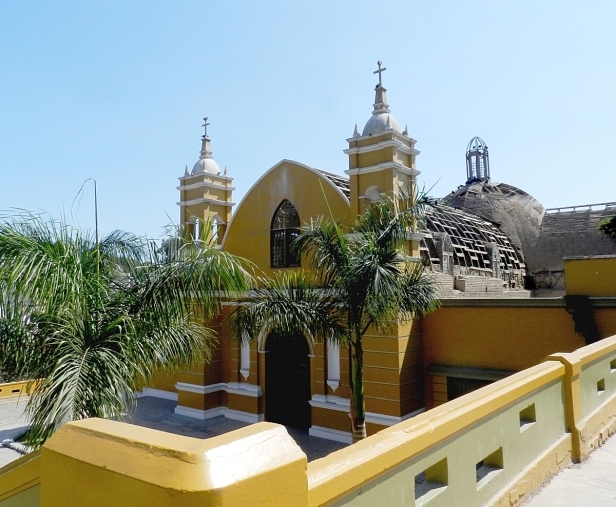
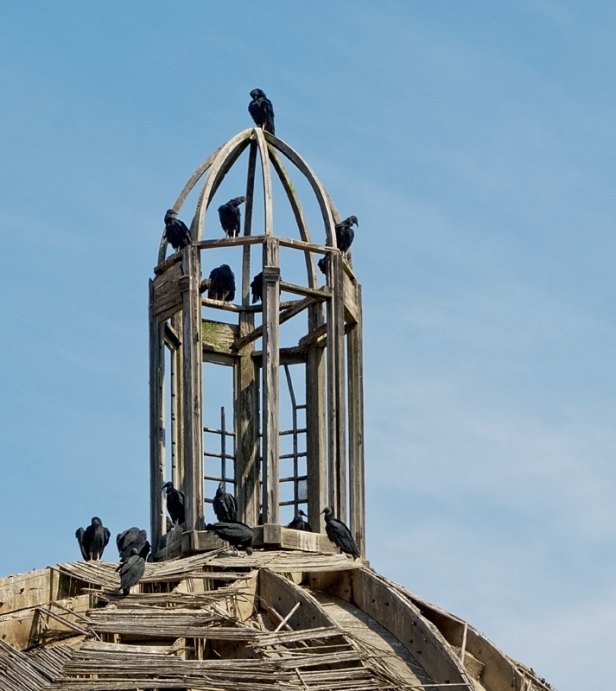
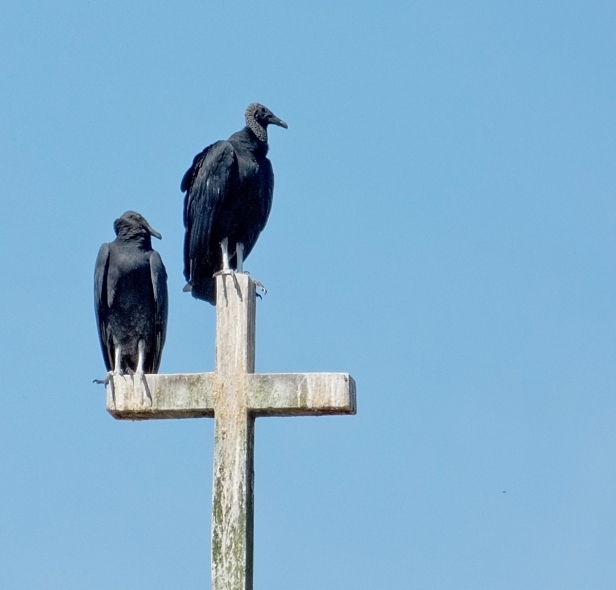
Absolutely the very best thing we did in Lima was go to the Circuito Mágico del Agua (Magic Water Circuit). A dusty park at the edge of the downtown area has been transformed by the municipal government into an enchanting circuit of more than a dozen grand fountains.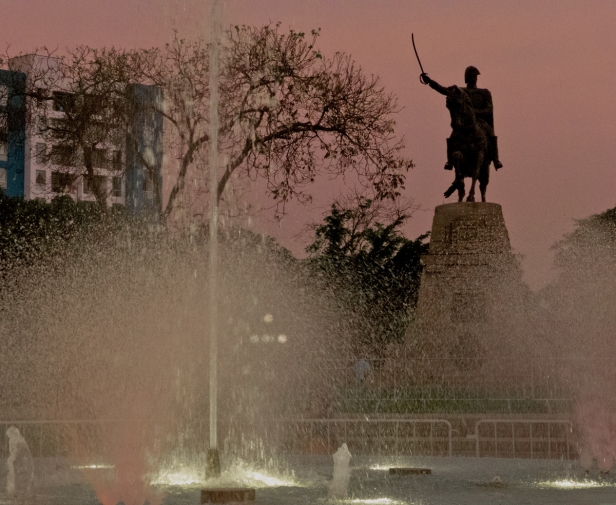
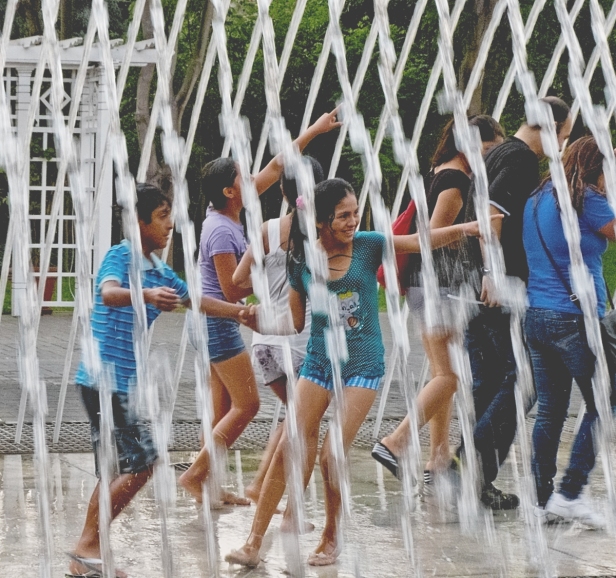
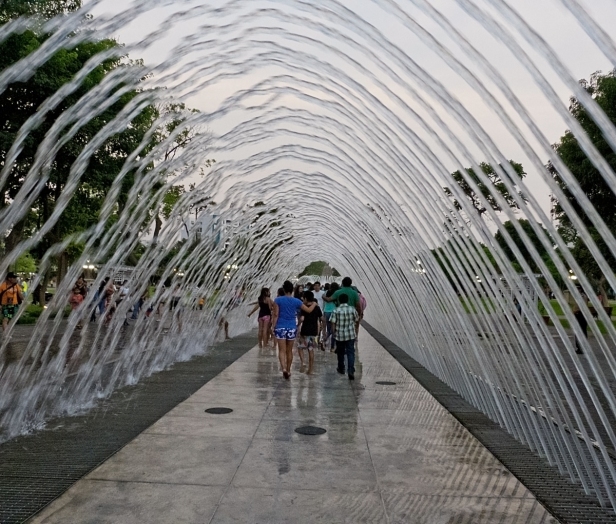
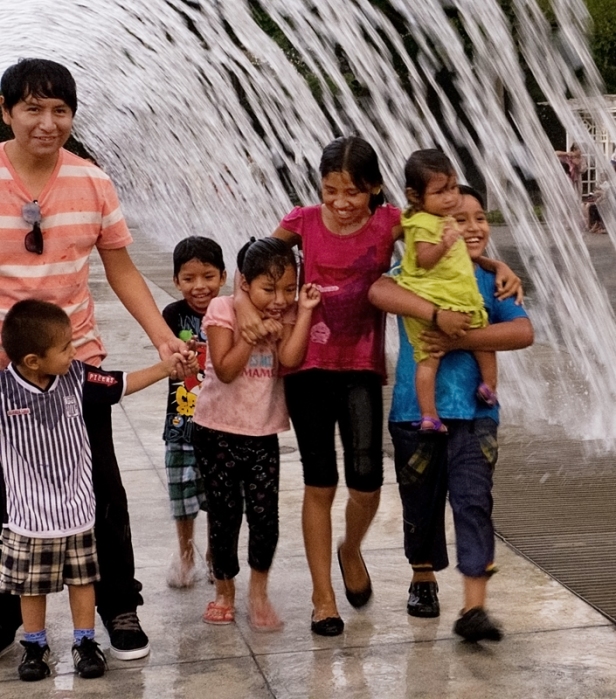
Yes we walked through the Tunnel of Surprises. And no we didn’t get wet. We watched kids, teenagers, families playing in the water both at the tunnel and in a water maze. We admired the many fountains all bursting with water in different configurations, creating misty rainbows and magical illusions. What a place. We were surprised by its beauty. But there was more to come. When it was time we took our places at the Fantasy Fountain for the show!
Fantasy Fountain is a single line of very high jets of water. In the centre section of the line the water is forced through so hard and fast that it comes out as mist. The mist is then used as the screen for a laser-light and film display all set to music. It was quite spectacular. Apart from lasers beaming intricate and ever-changing patterns, we saw giant flowers opening, humming birds sipping, several of the indigenous dances of Peru, and the Sugar Plum Fairy’s solo from The Nutcracker. It went on for about forty minutes. We were completely captivated. My photos don’t even begin to do it justice.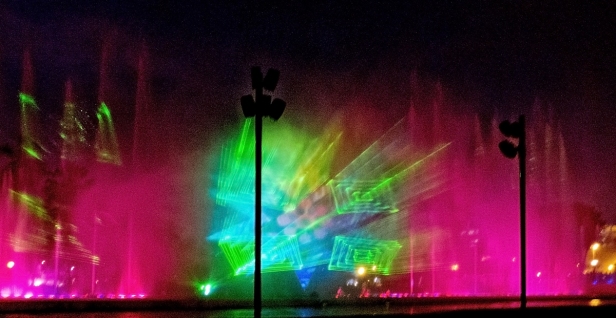
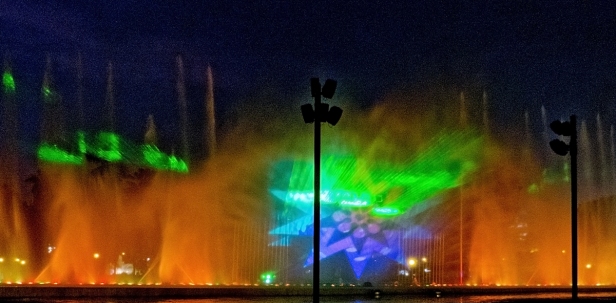
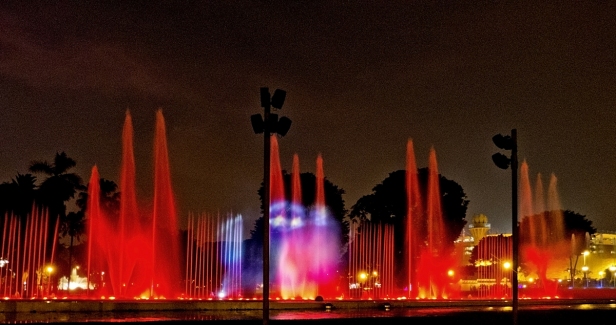
Next post: Changing the order of things a little. Even though we went to Candelaria from Lima, the next posts will be about our expedition into the Amazon. Slogging our way through the tangle and swamp of the jungle floor, or gliding silently through it in a canoe – now that was magical!
All words and images by Alison Louise Armstrong unless otherwise noted
© Alison Louise Armstrong and Adventures in Wonderland – a pilgrimage of the heart, 2010-2015.

The Water Circuit looks like so much fun! This is the first time I’ve heard about it despite all the guidebooks I’ve read for my trip to Peru – thanks for the recommendation. Can’t wait to hear how you get on in the jungle!
LikeLike
The water circuit was fabulous. If you’re going to be in Lima you should definitely try to go. Your blog is wonderful. I couldn’t stop reading. And your photography superb.
Have a great time in Peru! – Alison
LikeLike
Thank you, that’s so kind of you to say! Especially appreciated coming from seasoned bloggers like yourselves. 🙂
LikeLike
Still laughing about Don’s “waka fook yana” comment… Amazing about the bricks, and how lovely those fountains look!
LikeLike
Yes, Don had me laughing too 🙂
Those fountains are fabulous, and the show was truly splendid – way better than we could have imagined!
LikeLike
Wow. Those brick buildings are staggering in scope. But my favorite this time around is the water park, and the fountain of surprises.
LikeLike
Aren’t those brick buildings amazing?! I was floored by them – that a group of people would do such a thing. I can see putting in all that time and energy for useful buildings, which I’m sure they did build. Still I guess their pyramid to the gods is much the same as all mosques/temples/cathedrals anywhere.
I loved the tunnel of surprises. It’s so unique. I’ve never seen a fountain like it anywhere.
LikeLike
It’s perfect that with all the exhaustion ya’ll were recuperating from that you found the Magic Water Circuit. Water can be so healing and rejuvenating. Too bad we can’t just refuel like cars. The photos as always are terrific. xoxo
LikeLike
Thanks Paulette. We were completely entranced by the Magic Water Circuit. It was just lovely. Oh I do so wish we could refuel like cars, but I must say that after 10 days rest we are now improving. From a little online research we think it is likely that we both picked up (different) viruses in the Amazon which time and rest will heal.
LikeLike
I’m sure I’ve seen those yellow-walled balconies of Palacio Torre Tagle in a movie or two. Maybe the Government Palace and Plaza des Armas as well. They look familiar…
LikeLike
It wouldn’t surprise me. They are such grand and beautiful buildings I can see them being used in movies.
LikeLike
Good to hear that someone else besides us gets to a place and too tired to go out exploring, but it looks like you got over it, and got out and about. Great photos.
LikeLike
Thanks Angeline. We sort of got over it. Some places were definitely worth going to, but, yeah, at times it’s really a push; we’d just rather stay home. Like we’re doing here in Cyprus – been here 2 weeks and haven’t done any exploring at all. But we have 2 months here so still plenty of time.
I found your comment in the spam file!
LikeLike
Spam? Well I never….
LikeLike
The buzzards killing time up on the weathered, skeleton spire was a personal favorite. They must think the earthquake was just for them– feel as though they have squatter’s rights now to that crumbled yellow palacio. “We are holy now, too,” they are saying. “WE are watching over this place now.”
And those last few pictures of the fountains suggest some serious water artillery. Sounds like the show would have given the Bellagio a contest? I love how the families going through the water tunnel are touching and laughing.
Michael
LikeLike
We watched the vultures for a long time, and felt the same way, that they are watching over the church, have found their holy home. It was a ‘don’t mess with us’ kind of feeling 🙂
Have I made a mistake – are they buzzards not vultures?
I loved watching all the families in the water park – they were all having so much fun, so much joy and laughter.
The fountain light show was surprisingly truly spectacular. And the surprise made it even more so. I must see if I can catch a little of the Bellagio fountains on youtube – not heard about this before. Thank you.
Alison
LikeLike
I don’t even know if there is a distinction between buzzards and vultures. Maybe one is a more specific type of the other. I’m not sure. I started to ask you what kind of birds those were, then went back and read your writing and saw you had named them vultures, and I thought buzzard was probably close enough! I think they often refer to the same type of bird. Loitering up on a dilapidated structure like that, however, just said ‘buzzard’ to me… 🙂
Michael
LikeLike
I’d done a bit of research and found the exact same bird labeled a vulture and left it at that. Don just did a bit of a poke around and found out that in the US anyway the terms are interchangeable. So we’re both right 🙂
LikeLike
So cute -> waka fook yana is that?
Again, I just love the life that pops out of your photos – everything looks amazing! Maybe it’s what happens after a few years of living in Asia but I find the South American architecture, colors and costumes so refreshing and exotic to look at.
Can’t wait to read about your adventures in the Amazon!! 🙂
~Andrea<3
LikeLike
Thanks Andrea. I see you’ve been doing a little catch-up. Thank you!
I think you’re living in very ‘civilized’ Asia, but Vietnam still seems to be fairly exotic, and Myanmar definitely is. It’s true though that the indigenous costumes of South America, and especially of the Andes, are particularly inventive, unique and colourful.
The Amazon was Amazing! 🙂
Alison ❤
LikeLike
I suppose it’s like anything, what was once very exotic, which this all certainly was when we first arrived, has now become quite normal after 3 years of living here. We still love exploring all of the temples and taking in as many different Asian countries and cultures as we can get to, but the “wow” factor we once had with new eyes has changed.
We’re changing it up a bit next trip and heading to Sri Lanka, we’re thinking a bit of that new eyed “wow” factor will kick back in a bit! 🙂
South America seems to be in complete contrast to what we’ve been experiencing in Asia in almost every way. It seems like it would be a wonderful way to shake things up after a stint over here! We were once interested in teaching English in Argentina, maybe that’s something we will consider again.
I really can’t wait to read about your Amazon experience – talk about exotic!
~Andrea<3
LikeLike
I know what you mean about the ‘new eyed “wow” factor’ for sure. Sri Lanka should do it for you. I’d also highly recommend Myanmar.
Teaching somewhere in Sth America certainly would open up travel there. Santiago or Lima would be good places to teach too I think. Would def not recommend Quito if only because the city is extremely difficult to navigate. From my limited experience I’d go for Buenos Aires.
LikeLike
Myanmar is at the top of our list for SE Asia at the moment, but we’re doing a trip back home this January so it’s hopefully going to happen in Jan 2016. It’s starting to get inundated with tourists and we really want to see it before it loses its “untouched” feel.
That’s really good to know about Santiago or Lima as good options and Quito not so much – Your posts on Buenos Aires sounded incredible, I really want to experience that. It’s good to know there are lots of great options over there.
But now for the higher cost of living factor, as you mentioned in your other message…heading over there now.
LikeLike
We passed through Lima twice while in Peru, staying in town on one leg, and in Miraflores on the second trip. Lima, like Mexico City, takes some flexibility, and selective sight to really enjoy. The poverty is overwhelming, and impossible to ignore, but it’s a part of the Lima that will never go away. The Colonial part of Lima is delightful, and after our stay in downtown, Miraflores was a quiet delight. It’s one of those places that I’m glad I visited, but wouldn’t rush back to. ~James
LikeLike
I think you summed it up James – glad we visited but won’t rush back. Somehow we managed to find things in Mexico City that were real highlights for us – the shamans at the Zocolo, and the museum of folk art spring to mind. Still I do think maybe we’d have found more to enjoy in Lima had we had the time and energy.
LikeLike